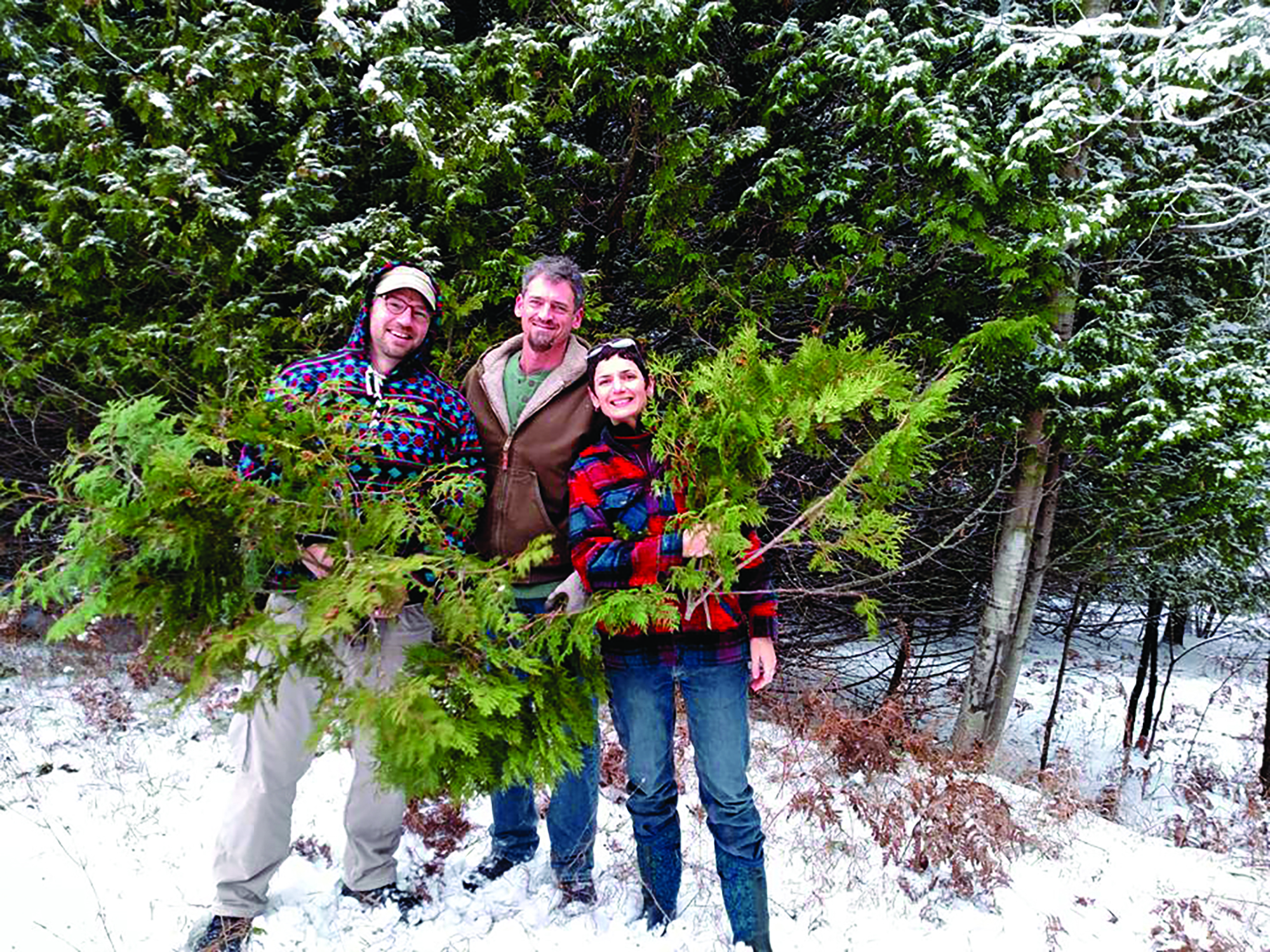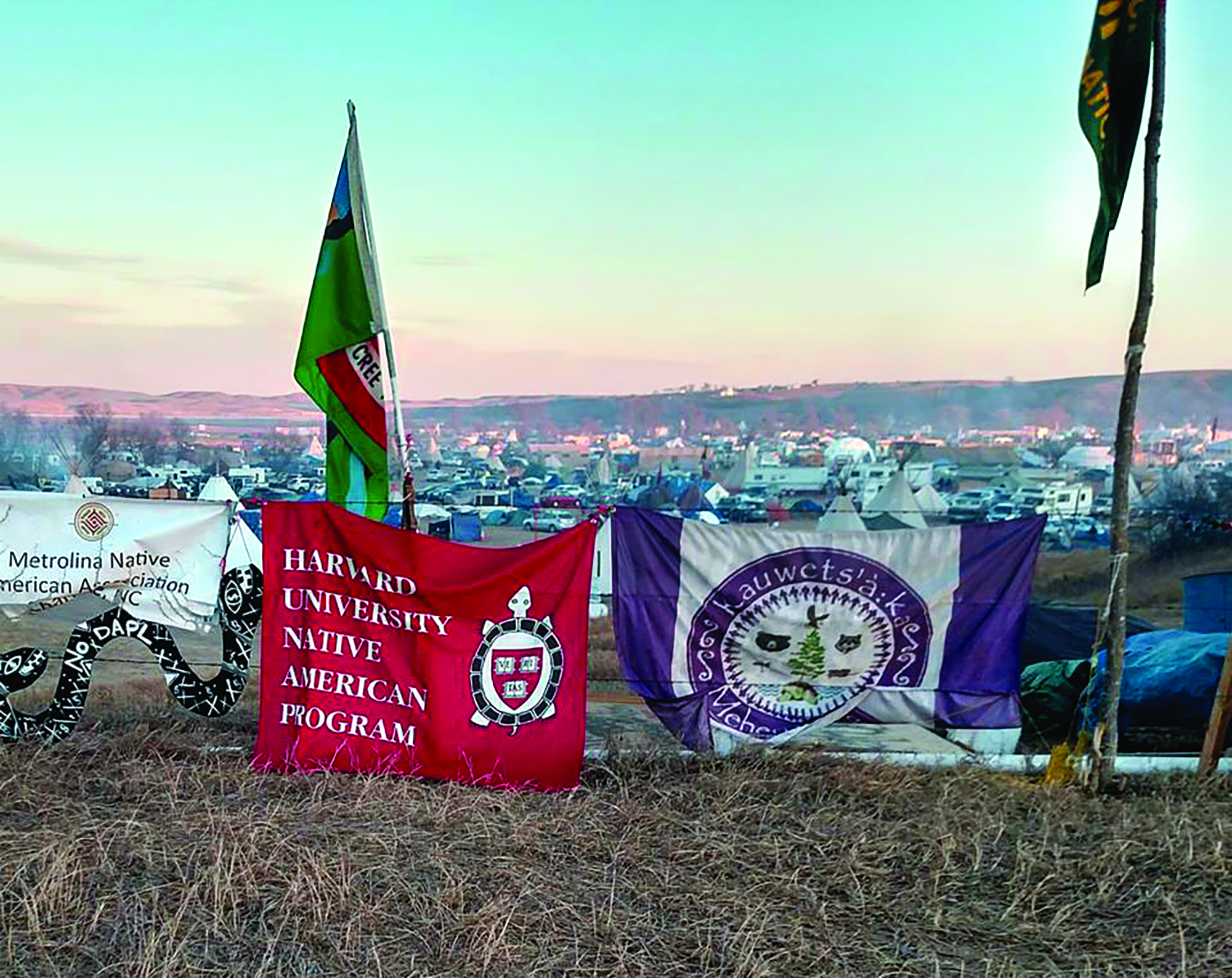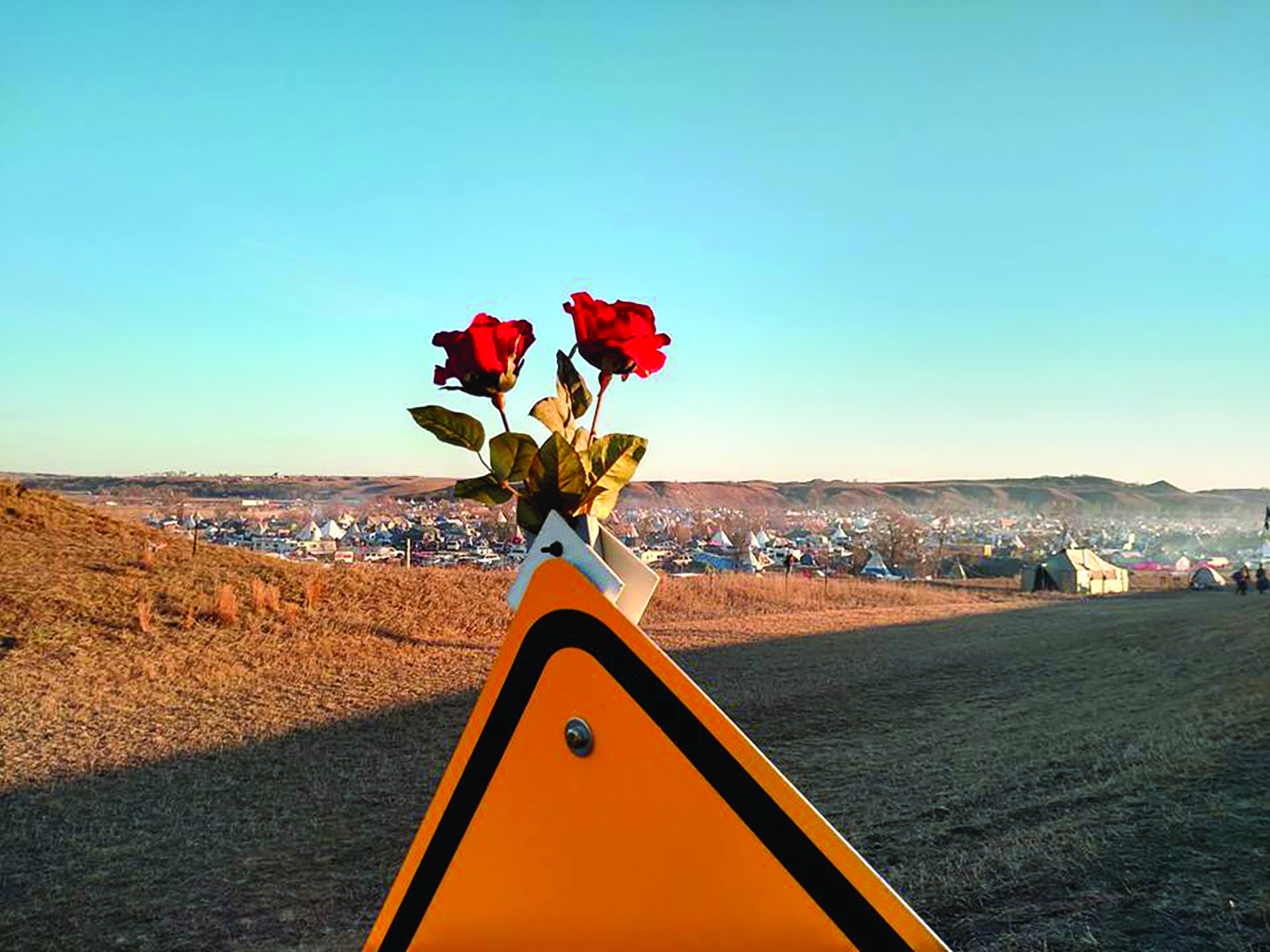A Benzie Thanksgiving among the Dakota Sioux to protest an oil pipeline.
By Jacob Wheeler
Current Editor
“They made us many promises, more than I can remember, but they never kept but one; they promised to take our land, and they took it.” —Dee Brown, Bury My Heart at Wounded Knee: An Indian History of the American West
Back in December 2014, Energy Transfer Partners LP first applied to build the 1,172-mile Dakota Access Pipeline, which would carry as much as 550,000 barrels of oil per day from western North Dakota to a terminal in Illinois. In the sixteen months that followed, the company and its subsidiaries went about checking off a list of state and federal regulators, trying to get the project going. In July 2016, prepatory construction work began—but the pipeline would face strong opposition.
In April 2016, a group of 200 Native Americans first rode on horseback to protest the pipeline’s location. The pipeline would allegedly compromise the drinking water and land that is considered sacred by the Standing Rock Sioux.
In the months since, the Standing Rock Sioux—and “water protectors” from many other tribes nationwide—occupied land along the Missouri River in an effort to stop completion of the Dakota Access Pipeline. Solidarity activists poured in from all over the continent and built yurts, tepees, and bunkhouses; they vowed to stay through North Dakota’s brutal winter. The demonstration escalated further in the first weekend of December, when the protesters were joined by thousands of U.S. military veterans, led by Wesley Clark, Jr. (son of the former supreme allied commander of NATO and one-time presidential candidate).
Then, on December 4—just one day before the threat of eviction—the months-long struggle paid off. The U.S. Army Corps of Engineers announced that it would not allow the pipeline to be drilled under a dammed section of the Missouri River and would seek alternative routes for the $3.7 billion pipeline.
Thanksgiving of Solidarity
Just two weeks before, however, the situation still looked unclear, and supporters from all across the nation were taking time away from work and their families to drive supplies to North Dakota.

For instance, Benzie residents Joshua Stoltz and Cathye Williams, did not overeat turkey, then fall asleep to a football game this past Thanksgiving. Rather, they—along with Antrim County’s Ric Evans—observed the holiday of “gratitude” and “giving” in a much more authentic manner. They traveled to Standing Rock, near Cannon Ball, North Dakota, to join the largest First Nation protest and land defense in more than a century. They brought with them supplies to support their friend, Lee Sprague, a Native American activist from Manistee County.
Stoltz is executive director of Grow Benzie, where more than 50 people attended a November 16 community dinner, raising $750 in donations for the water protectors. After the event, donations of fresh local produce, a generator, kerosene heaters, batteries, medicine, subzero sleeping wear, camp safety gear, ropes, building supplies, and herbal remedies came rolling in. So, the day before Thanksgiving, they packed it all into a car and headed West. They also transported a bag of sage and fresh-cut, local cedar branches that were to be blessed and hung in the camp’s main fire shelter.
After a brief nocturnal respite in the Twin Cities with their friend, Pastor Justin Grimm (who led a congregation in Lake Ann just a few years back), they left at 6 a.m. on Thanksgiving Day to reach Oceti Sakowin Camp before nightfall and to break bread with Sprague.
Williams, a social worker with Child and Family Services of Northwestern Michigan, proclaims to be an advocate for the environment. She attributes her work with Citizens’ Climate Lobby as what attracted her to the struggle at Standing Rock.
“Anybody working peacefully and legally to keep fossil fuels in the ground garners my support,” she says.
She also wanted to bear witness. She questioned the tone of the media coverage that she had been reading about Standing Rock, and she suspected the characterizations of the protest and water protectors.
“They just didn’t jibe with what I was hearing from people I knew who there on the ground,” Williams says.
Eating and Ingenuity
On Thanksgiving afternoon, Stoltz posted on Facebook: “We’ve reached Dakota Territory. Plains are desolate and barren, only broken apart by scattered patches of trees. These timber stands seem to grow around bogs and creeks, and most are inhabited by homesteaders for water source and wind protection. Temps have dropped to near freezing, fog is spotty.”
Once they arrived at the Pueblo Camp where Sprague was staying, together with tribes from the Southwestern United States, they took advantage of the remaining daylight and got to work. Temporary buildings made out of sticks had to be insulated for the frigid winter to come; kindling was distributed around camp to keep the home fires burning; dishes need to be washed; incoming donations of goods needed to be organized, and water-rescue equipment was delivered to the Michigan canoe team, which Sprague was a part of. (The team helped to forge the water between main camp and Turtle Island, where Standing Rock Sioux ancestors are buried.)
Only after the sun set did the cooking begin. Stoltz made what he called a “freaky-fresh Thanksgiving salad” using heirloom tomatoes from Grow Benzie, cucumbers, greens, eggplant, peppers, and honey from Benzie and Manistee counties. Someone delivered a duck soup and homemade bread, which Stoltz found delicious. To the salad, the Benzie contingent added a cooked squash and mushroom stuffing. Some sat to enjoy the meal. Others nibbled as they continued to work. Stories abounded.

Williams remembers that one of the cooks was a young man from Chicago who played other roles in camp, such as a builder and water rescuer. Like many others, “he was still hurting from the teargas and pepper spraying” that the militarized police had fired at occupiers the previous Monday morning, November 21, in an effort to break up the peaceful demonstration. (One woman, Sophia Wilansky from New York City, all but lost her left arm to a police concussion grenade and had to be evacuated by helicopter to Minneapolis.)
Despite the violence inflicted on Standing Rock just five days earlier, and the threat of more police actions to come, the water protectors found joy in the presence of the newcomers. Over duck soup and bread, Stoltz joined a daily meeting.
“I listened to an elder from Pueblo Camp talk specifically about how he was thankful for neighbors and new folks to join them and help with the work,” Stoltz says. “We were celebrating our time together.”
As the workers grazed on the food before them, they constantly surveyed the work that needed to be done next. Stoltz would awake early on Friday morning to cook breakfast for a group of 50. Then they set up snack and lunch buffets at different intervals. Huge quantities of traditional Thanksgiving fare also arrived on that Friday.
Stoltz was impressed at the structure and communal living that was spontaneously growing out of the plains—in what felt like a war zone.
“I was really in awe of organization that was happening, witnessing leaders making decisions based on things happening on the ground,” he says. “They were building solar and wind to help power the camp. They were finding experts to fix problems. There was ingenuity and communication. For them to grow exponentially in a small period of time is pretty inspiring. And to be resilient against obstacles and the unknown.”
When Williams looked around Pueblo Camp, she saw people from all walks of life: native, non-native, young, old, students, teachers, artists, engineers, medical personnel, and military.
“All were grounded and carried respect for ancestors, elders, and the earth in all their tasks,” she says. “All were solemn and steadfast in their cause, without losing their spirit and good humor. There was peaceful intent with every act undertaken in this camp. We were thankful and honored to be there—sharing food, energy, and work with these people as they took on this monumental task of standing for their land, their water, their sacred sites, and their culture. In doing so, they protect the water and earth for all of us.”
True Meaning
Though the Benzie activists were delivering supplies—including a harvest meal—during our American Thanksgiving weekend, Williams found little synergy with our popular folk tale of the holiday’s genesis.
“Long ago, I came to realize that Thanksgiving—as the quaint story of settlers breaking bread with natives—was a myth,” she says. “[Rather, what’s] challenging for me is the guilt and sorrow that America’s wealth and all-too-easy way of life is built on the mistreatment and disenfranchise of indigenous people.”
Other Northern Michigan activists who traveled to Standing Rock during Thanksgiving expressed similar sentiments.
“Colonization has been devastating to the native culture,” says Suttons Bay original Luke Speicher, who traveled to Standing Rock from Marquette. “Celebrating a pleasant feast on the basis of pilgrim-and-native interaction feels so false.”
Traverse City teacher Jamie Lee Schaub traveled to North Dakota in her Volvo with her partner, Brenin Wertz-Roth. They brought winter outdoor gear, dry suits, neoprene gear, blankets, boots, propane, tools, building materials, space blankets, batteries, a turkey, squash, corn, maple syrup, hot sauce, potatoes, and nearly $3,000 that they received in donations from friends and family. Along the road, they kept getting donations and stopped at stores and homes (via Craigslist) to purchase more supplies.
“I was teaching my students about Thanksgiving only a couple weeks ago,” Schaub says. “Now I am here, giving what I can to native people who are standing and protecting. Thinking about actually giving during Thanksgiving—instead of sitting around a table and eating—felt much more important and meaningful. I can only hope this becomes a strong, sustainable community, without a black snake polluting the land and water.”
Schaub is referencing a native prophesy of a “black snake,” which many have been interpreting as the oil pipeline. If the Army Corps of Engineers do, in fact, reroute the Dakota Access Pipeline away from Sioux territory, it may spare Standing Rock, but the “black snake” will still slither the earth. What then?
“I hope that word spreads and support grows for Standing Rock,” Speicher says. “I hope people wake up and realize how oil dependence is affecting our earth. I want people to know the indigenous struggle is not over. This is just another example of white people doing whatever they want to native people. The people are strong. The oil companies have force, but Standing Rock has power.”
“While the denial of the permit by the Army Corps of Engineers for the DAPL pipeline is a historical victory in terms of the acknowledgement of indigenous rights, and private property rights in general,” Evans says, “the crushing fact remains that the pipeline CEO stated that ‘this decision changes nothing—the pipeline will be built, at it’s current location.’ So don’t let up; don’t keep your eyes off this for a second—this is far from over.”
Williams hopes that the David vs. Goliath-like struggle on the North Dakota plains holds a lesson for the fossil fuel industry.
“My hope is that the movement will prevail, cause the fossil fuel companies enough expense and trouble to see the writing on the wall for destructive extractive processes,” she says. “My hope is that our leaders will realize that voices for the Earth won’t be silenced and that clean air water and land are more important that giant corporations and personal wealth beyond all reason.”
All photos courtesy of Cathye Williams.
Jacob Wheeler has taken a full-time job with Groundwork Center for Resilient Communities (formerly the Michigan Land Use Institute). Following this issue, he will step down as editor of The Betsie Current, though his byline may reappear from time to time. Wheeler will continue to publish our sister publication, the Glen Arbor Sun. He wishes the remaining editors of The Betsie Current the best of luck.





Wonderful article, Jacob, about fabulous people !! Thanks for this, and good luck in your new adventure – the Current will miss you!
Susan Koenig